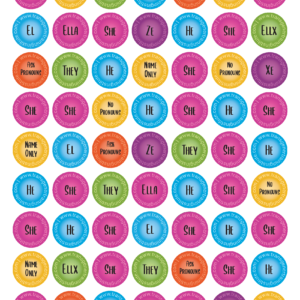
The American Dialect Society declared the singular “they” the 2015 word of the year, which is now a recognized and grammatically correct singular pronoun.

Non-binary gender identities are not associated with a specific gender expression and some may reject gender "identities" altogether. Some others use conventional gender-specific pronouns 'her' or 'him', alternately use 'he' and 'she', or use only their name and do not use pronouns at all while still others choose to use the gender-neutral pronouns “ze/hir/hirs” (pronounced “zee/here/heres”) or “ey/em/eir” (pronounced “ay/em/airs”), among others. There are non-standard pronouns such as xe, ze, sie, co, and ey are sometimes used as well. The most common gender-neutral pronoun used by genderqueer and gender nonconforming people is “they/them/their,” but that does not mean it is the only option. We live in a society where gender refers to the gender each individual identifies rather than one’s biological sex.

Similarly, transmasculine may be used by individuals who were assigned female at birth but align more closely with masculinity, while not necessarily fully identifying as a man ( ). Transfeminine may be used by individuals who were assigned male at birth but align more closely with femininity, while not necessarily fully identifying as a woman. Transfeminine and transmasculine may be used by individuals to describe an aspect of femininity or masculinity within their identity. A demi flux person feels that the stable part of their identity is non-binary. Demi gender is a gender identity of a person identifying partially or mostly with one gender and at the same time with another gender.
#GENDER FLUX PRONOUNS FREE#
Non-binary people may identify as having two or more genders (being bigender or trigender) having no gender (agender, nongendered, genderless, gender free or neutrois) moving between genders or having a fluctuating gender identity (genderfluid) being third gender or other-gendered (a category that includes those who do not place a name to their gender). Non-binary or genderqueer are not exclusive masculine or feminine identities and fall outside the gender binary. Non-binary identities can fall under the transgender umbrella, since many non-binary people identify with a gender that is different from their assigned sex. Gender is determined exclusively by ‘self-identification’. There are also non-binary individuals who identify as neither male nor female. The words “he” or “she” are pronouns which do not provide the means to self-expression. Gender diverse people find it extremely limiting having to express themselves as either male or female.

Gender Diversity has firmly entrenched itself in our society and is the term used to describe gender identities that demonstrate a diversity of expression beyond the binary framework. It is highly adaptable and makes room for the addition of gender-neutral pronouns. Language is an exciting topic and as with all things, it is continuously evolving and morphing.


 0 kommentar(er)
0 kommentar(er)
